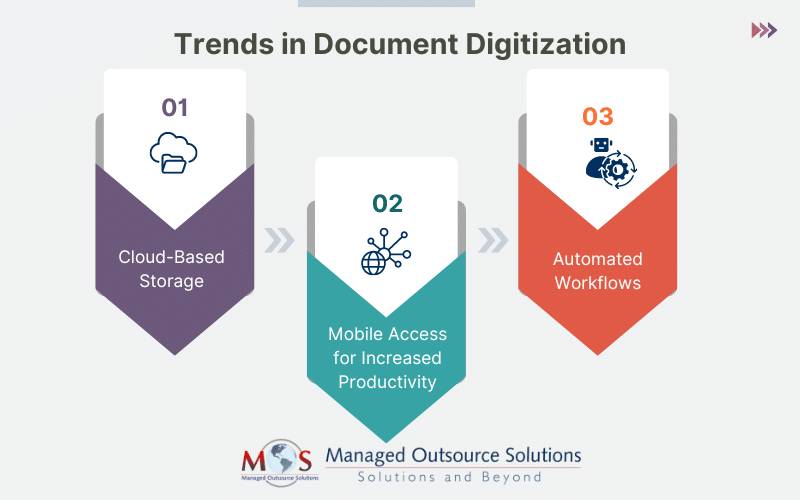Businesses should have new capabilities to be innovative, well-connected, innovative, efficient and most importantly to be able to satisfy both the present and future needs of the customers and going paperless with reliable data conversion companies is one of the ways to improve the efficiency and productivity of the organization. Digital transformation is often tedious and failure prone, and requires keen attention to detail.
Enterprises as well as consumer technology are all set to mark the whole new world of transformation where people will not change but their lifestyles will change. Global spending on digital transformation is expected to reach 3.9 trillion dollars by 2027, according to Statista. Digitization is being fueled by advancements in technology, such as cloud computing, artificial intelligence (AI), and big data analytics, which enable greater efficiency, improved customer experiences, and enhanced decision-making. Moreover, the trend of hybrid work which combines remote and in-office work, and demand for digital services has driven organizations to rapidly adopt digital solutions.
Latest Trends in Document Digitization
- Cloud based storage: Cloud-based storage is revolutionizing the digitization of documents by providing improved scalability, accessibility, and collaborative features. Cloud storage solutions, as opposed to conventional on-premises storage, let companies access documents on any internet-connected device, from any location, at any time. This adaptability facilitates distant work and easy team collaboration, increasing productivity and decision-making. To ensure consistency and expedite project schedules, a worldwide marketing agency, for example, can consolidate campaign materials in the cloud and enable team members from many locations to contribute in real-time. Furthermore, flexible choices offered by cloud storage allow enterprises to modify storage capacity as needed without incurring expensive infrastructure improvements. Due to this, it’s ideal for startups and small organizations that want adaptable, affordable solutions to handle expansion or changing needs.
- Increasing Productivity Anytime, Anywhere with Mobile Access: For modern firms, mobile access to digital documents is vital since it enables employees to continue working productively from any location. Employing mobile-friendly document digitization technologies can help businesses increase productivity, flexibility, and teamwork. Sales reps can improve customer satisfaction and outcomes by responding to client inquiries and closing deals in real-time using their smartphones or tablets to access customer contracts, proposals, and product specs. Furthermore, mobile access enables workers to finish projects during client meetings, fieldwork, or remote work—all of which take place outside of regular business hours. This capability enhances overall efficiency, which also improves decision-making speed and responsiveness to business demands.
- Streamlining Procedures and Increasing Productivity with Automated Workflows: Automated workflows are revolutionizing document digitization, increasing productivity and streamlining procedures. By utilizing technology such as robotic process automation (RPA) and artificial intelligence (AI), firms can decrease the need for human interaction in processes that revolve around documents. The human resources departments may automate employee onboarding, for example, with little work by digitizing papers, extracting data from forms and resumes, and routing them for approval. This guarantees adherence to corporate rules and laws, expedites onboarding, and lessens administrative burdens. Furthermore, automated workflows facilitate data-driven decision-making by extracting insightful information from digitized documents. Financial institutions, for instance, can evaluate loan applications, gather important information, and decide which loans to approve based on creditworthiness with the use of AI-powered analytics. Businesses may increase productivity, streamline procedures, and make better decisions by embracing automation.
Tips to Enhance Digital Record Accuracy and Efficiency
When an organization goes digital it is important to ensure that all important information about the customers, employees and shareholders are kept safe. To ensure accuracy of the digital record and boost operational efficiency, consider following these tips:
- Improve employee’s technological literacy: Employees should be able to understand the new technology, communicate data and prioritize timelines. Employees should be also provided with enough training period to learn and understand the new digital system. This will help to work comfortably and gain the benefits of using a digital system.
- Develop a digital first culture: Build a digital culture in your organization gradually. Employees may have different backgrounds and personalities. So it is important that everyone should know and build up a digital work culture in the organization.
- Centralize your database: Having all of your data in one location can significantly improve data quality, which is why centralizing your database can be so beneficial. You can make sure that your data is accurate, consistent, and easier to use by keeping it all in one place. A centralized database is frequently essential, whether your goal is to prevent errors and duplication or to combine data from multiple sources. It also gives you an unmatched picture of your data, allowing you to set up governance guidelines to preserve the accuracy of your data.
- Conduct routine data audits: Conducting routine audits is essential for enhancing the quality of data in a business. To ensure that your data is great and maintained, it is essential to conduct regular reviews and audits. Corporate executives can handle a range of challenges and make informed decisions by using data audits, including the security and integrity of customer data. Furthermore, an audit may help identify access issues and silos that would otherwise go unnoticed. Make data auditing a regular component of your data management strategy to preserve data integrity over time, yield insightful findings, and promote company expansion.
- Create a standard for data quality: Setting up excellent data standards that are followed by the entire company is one of the best strategies to increase the correctness of your data. Since different stakeholders within an organization are likely to have differing degrees of business sensitivity, culture, and maturity, there may be differences in the way and pace at which data quality enablement demands are handled. By defining and enforcing data quality standards, organizations may make sure that different stakeholders are aware of and following the agreed-upon guidelines. This action will facilitate implementation and help educate all parties concerned.
- Put strong data security procedures in place: Improving data quality requires the implementation of robust data security measures. To prevent unwanted access to sensitive data, companies should first implement multi-factor authentication, user authentication methods, and rigorous access controls. Strong encryption should safeguard information both in transit and at rest, granting access to only those who are allowed. Data breaches are less likely when risks of cyber-attacks are identified and prevented with the use of intrusion detection systems and robust firewalls. Vulnerabilities can be proactively identified by routine penetration tests and security audits. These steps can protect consumer information, improve data quality, and guarantee regulatory compliance.
Organizations have huge volumes of data flowing in on a daily basis and it is very important to keep all the data in digital form to survive in the competitive world. If the data resides in paper format, the practical way would be to partner with a reliable service provider that can assist in bulk document scanning. By partnering with a data conversion company, enterprises can efficiently convert their existing paper-based records, optimize their workflows, and gain access to the latest digital trends that will help them thrive in today’s competitive landscape.





